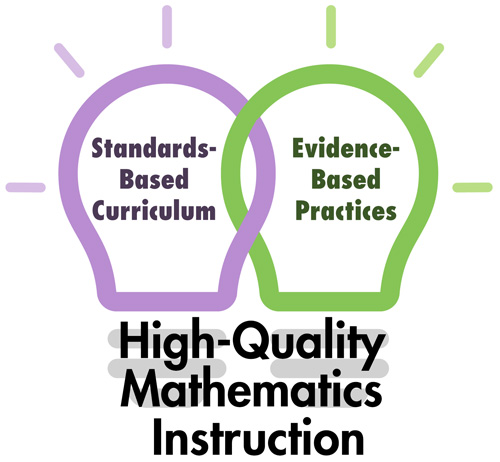High-Quality Mathematics Instruction: What Teachers Should Know
Wrap Up
 In the United States, approximately two-thirds of all students have not mastered the expected grade level mathematics concepts and procedures. For students with disabilities and English learners (ELs), the percentages are closer to 90%. To improve students’ mathematics performance, there has been a growing focus on implementing high-quality mathematics instruction. This instruction involves the combined implementation of both:
In the United States, approximately two-thirds of all students have not mastered the expected grade level mathematics concepts and procedures. For students with disabilities and English learners (ELs), the percentages are closer to 90%. To improve students’ mathematics performance, there has been a growing focus on implementing high-quality mathematics instruction. This instruction involves the combined implementation of both:
- A standards-based curriculum — Outlines the skills and concepts believed to be important for students to learn and focuses on the conceptual understanding of mathematical principles (the why) and the connection between them. Many states have adopted the Common Core State Standards for Mathematics (CCSSM), which outline the skills and concepts believed to be important for students to learn at each grade level.
- Evidence-based practices (EBPs) — Strategies or practices proven through research to be effective for teaching mathematical concepts and procedures.
The table below describes four practices highlighted in this module that have been found effective in improving the outcomes of students with mathematics difficulties and disabilities.
| Evidence-Based Practice | Definition |
| Explicit, systematic instruction | This strategy involves teaching a specific skill or concept in a highly structured and carefully sequenced manner. |
| Visual representations | This strategy involves creating an accurate representation of the mathematical quantities and relationships described in the problem, sometimes referred to as a schematic representation or schematic diagram. |
| Schema instruction | This strategy involves teaching students the underlying structure, or schema, of word problems and giving them a method for solving that problem type. |
| Metacognitive strategies | These strategies enable students to become aware of how they think when solving mathematics problems. More specifically, metacognitive strategies help students learn to plan, monitor, and modify their mathematical problem-solving approach. |
In addition to these EBPs, there are a number of additional classroom practices teachers can implement to increase the mathematical understanding of their students. These include:
- Encouraging student discussion
- Presenting and comparing multiple solution strategies
- Assessing student understanding
Teachers who implement high-quality mathematics instruction see an improvement in students’ mathematical performance.
Listen as Lois Coles, who began her career teaching math using traditional methods, discusses the positive effects of using a standards-based curriculum and effective practices (time: 1:40).
Lois Coles
Eighth-Grade Mathematics Teacher
Brentwood Middle School

Transcript: Lois Coles
Traditional mathematics instruction focused on memorization, drill-and-practice, and the application of those procedures, and what I call “contrived word problems” found in the textbook. Where standards-based learning emphasizes the development of conceptual understanding, reasoning, collaborative learning, and the application of understanding, and what we do, performance-based tasks. We use mathematics outside the classroom every day. Teaching a standards-based curriculum using those best practices and sound teaching strategies sets students up for success not only in my classroom but in future math classes in high school and also later in life in the world of work. In my classroom, students are exposed to a rigorous curriculum to daily engage and move them toward becoming self-directed learners. They’re exposed to a plethora of teaching strategies that will enable them to think creatively through the problem-solving process. Many of the problem-solving strategies that we use everyday in my math class can be applied to real-life situations in the world. I create the future every day in my classroom by empowering my students to think outside the box.
Students sometimes want the easy way out and want me to teach them the quickest, shortest way to solve a problem. However, they often come to realize that they better comprehend the material when I teach for understanding through the discussions and writing about the process, analyzing their errors, and by providing them with multiple representations and methods of how to solve the problem, as students do not all learn the same.
As Lois Coles mentioned, traditional mathematics instruction has focused on procedural knowledge and has placed little emphasis on students’ conceptual understanding. By implementing high-quality mathematics instruction—a standards-based curriculum and evidence-based practices—teachers can improve students’ conceptual understanding of mathematics, which results in better student performance.
Revisiting Initial Thoughts
Think back to your initial responses to the following questions. After working through the resources in this module, do you still agree with your Initial Thoughts? If not, what aspects of your answers would you change?
What is high-quality mathematics instruction and why is it important?
What evidence-based mathematics instructional strategies can teachers employ?
When you are ready, proceed to the Assessment section.